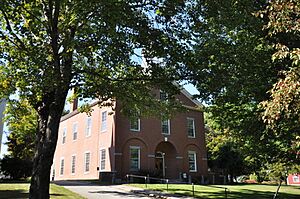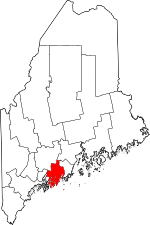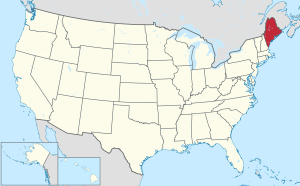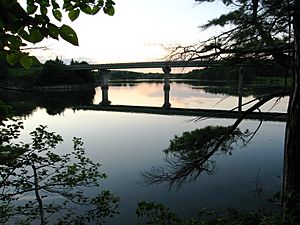Lincoln County, Maine facts for kids
Quick facts for kids
Lincoln County
|
||
|---|---|---|

Lincoln County Courthouse
|
||
|
||

Location within the U.S. state of Maine
|
||
 Maine's location within the U.S. |
||
| Country | ||
| State | ||
| Founded | 1760 | |
| Named for | Lincoln, England | |
| Seat | Wiscasset | |
| Largest town | Waldoboro | |
| Area | ||
| • Total | 700 sq mi (2,000 km2) | |
| • Land | 456 sq mi (1,180 km2) | |
| • Water | 244 sq mi (630 km2) 35%% | |
| Population
(2020)
|
||
| • Total | 35,237 | |
| • Estimate
(2023)
|
36,507 |
|
| • Density | 50/sq mi (19.4/km2) | |
| Time zone | UTC−5 (Eastern) | |
| • Summer (DST) | UTC−4 (EDT) | |
| Congressional district | 1st | |
Lincoln County is a special area in the state of Maine, located in the northeastern part of the United States. It's like a big district with its own local government. In 2020, about 35,237 people lived here. The main town where the county government is located is Wiscasset.
Lincoln County was created in 1760. It was formed from a part of York County, Massachusetts. The county was named after the city of Lincoln in England. This was the hometown of Thomas Pownall, who was a governor of the Massachusetts Bay area a long time ago.
When it was first created, Lincoln County was huge! It covered about three-fifths of what is now Maine. It even stretched all the way to Nova Scotia in Canada. Over time, 13 other counties were formed from this large area. These include Sagadahoc County to the west and part of Kennebec County to the north. The county has a traditional New England flag, which was chosen in 1977.
Contents
Geography of Lincoln County
Lincoln County covers a total area of about 700 square miles. About 456 square miles of this is land. The rest, about 244 square miles (or 35%), is water. This makes it the third-smallest county in Maine by land area.
Neighboring Counties
Lincoln County shares its borders with several other counties:
- Kennebec County is to the north.
- Waldo County is to the northeast.
- Knox County is to the east.
- Sagadahoc County is to the west.
People and Population
| Historical population | |||
|---|---|---|---|
| Census | Pop. | %± | |
| 1790 | 29,733 | — | |
| 1800 | 30,225 | 1.7% | |
| 1810 | 42,992 | 42.2% | |
| 1820 | 53,189 | 23.7% | |
| 1830 | 57,192 | 7.5% | |
| 1840 | 63,517 | 11.1% | |
| 1850 | 74,875 | 17.9% | |
| 1860 | 27,860 | −62.8% | |
| 1870 | 25,597 | −8.1% | |
| 1880 | 24,821 | −3.0% | |
| 1890 | 21,996 | −11.4% | |
| 1900 | 19,669 | −10.6% | |
| 1910 | 18,216 | −7.4% | |
| 1920 | 15,976 | −12.3% | |
| 1930 | 15,498 | −3.0% | |
| 1940 | 16,294 | 5.1% | |
| 1950 | 18,004 | 10.5% | |
| 1960 | 18,497 | 2.7% | |
| 1970 | 20,537 | 11.0% | |
| 1980 | 25,691 | 25.1% | |
| 1990 | 30,357 | 18.2% | |
| 2000 | 33,616 | 10.7% | |
| 2010 | 34,457 | 2.5% | |
| 2020 | 35,237 | 2.3% | |
| 2023 (est.) | 36,507 | 5.9% | |
| U.S. Decennial Census 1790–1960 1900–1990 1990–2000 2010–2016 2018 |
|||
2010 Census Information
In 2010, there were 34,457 people living in Lincoln County. There were 15,149 households, which are groups of people living together. The population density was about 75.6 people per square mile.
Most people in the county were white (97.6%). Smaller groups included Asian (0.5%), American Indian (0.3%), and Black or African American (0.3%). About 0.8% of the population was of Hispanic or Latino background.
Many people in Lincoln County have ancestors from different countries. About 30.4% had English ancestors. About 17.7% had Irish ancestors. German ancestors made up 13.4% of the population. Scottish ancestors were 8.6%, and 8.5% identified as American.
The average age of people in the county was 48.1 years old.
Towns and Communities
Lincoln County has many different towns and communities.
Towns
Plantations
Unorganized Territories
These are areas that don't have their own local government.
Census-designated places
These are specific areas identified by the census for data collection.
Transportation
U.S. Route 1 is a major road that goes through Lincoln County. It runs from the northeast to the southwest. Other important roads are Maine State Routes like Maine 27, Maine 129, Maine 130, and Maine 32. These roads travel north into the county's inner areas and south to the coastal peninsulas.
For many years, trains were an important way to travel. Until 1958, the Maine Central Railroad ran passenger trains through the county. These trains connected places like Portland and Rockland. There were train stations in towns like Wiscasset, Newcastle, and Waldoboro. These trains also connected to other major cities like Boston and New York City. Train service stopped in 1959.
More recently, from 2003 to 2015, the Maine Eastern Railroad offered special train trips during certain seasons. These trips went to Rockland and connected with Amtrak's Downeaster service. There are also plans to extend the Downeaster train service to Rockland on weekends during the summer. This would include stops in Bath, Wiscasset, and Newcastle.
See also
 In Spanish: Condado de Lincoln (Maine) para niños
In Spanish: Condado de Lincoln (Maine) para niños




